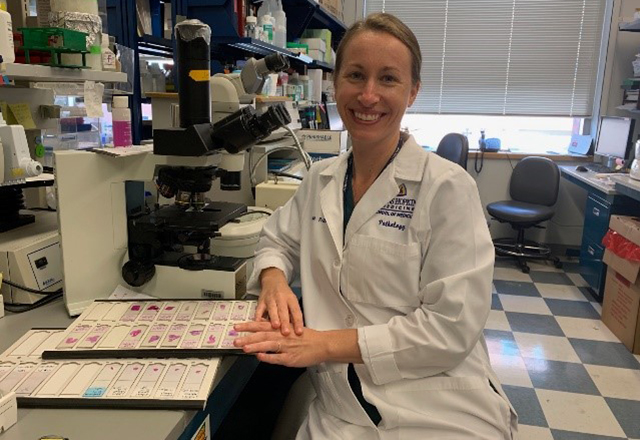While the Johns Hopkins University School of Medicine may be known for its rigorous M.D. and Ph.D. programs, we also boast top-notch veterinary residency programs. Housed by the Department of Molecular and Comparative Pathology, there are two different residency programs: Post-DVM Pathology Training and Post-DVM Lab Animal Training. Within each training program, there are two tracks, research or clinical. With each program accepting one to two new trainees per year, the cohorts are small and intimate, allowing for an immersive and interactive training experience.
Lauren Peiffer, D.V.M., a fifth year in the pathology training program, knew she was interested in becoming a veterinary pathologist when she volunteered at a wildlife clinic before veterinary school. The clinic did extensive surveillance on animals in the area to keep abreast of arising disease outbreaks, so she completed many necropsies (autopsies performed on animals) during her time there. She specifically recalls her first necropsy, a great horned owl, and how fascinated she was by what she saw. Her newfound interest in pathology prompted her to apply to veterinary school at Iowa State University, which houses Iowa’s state diagnostic lab, and therefore has a large caseload available for students to use for training.
After graduating from veterinary school and practicing as a clinical veterinarian for several years, Peiffer decided to pursue her goal of becoming a veterinary pathologist. “[Hopkins] has one of the premier research programs for veterinary scientists,” she says. The research track, which a majority of fellows choose, allows trainees to earn a Ph.D. in a program within the school of medicine during their time in the training program. In addition to this, Johns Hopkins uniquely allows D.V.M.s who already have Ph.D.s to conduct their own postdoctoral research during the training program.
The second year of the residency program is when the fellows begin their Ph.D. programs if they are on the research track. Peiffer describes this time as challenging, with many academic, laboratory and pathology responsibilities to juggle. Some of these duties include being on call, performing biopsies on specimens from the Maryland Zoo in Baltimore and the National Aquarium, courses through the residency program and Ph.D. program, as well as laboratory rotations. Courses for the pathology training program include systems pathology; gross rounds, where fellows discuss cases; OneHealth Seminar, which includes research talks; and slide conference, where a fellow selects slides for their colleagues to analyze.
While managing these various responsibilities is a demanding task, Peiffer finds that her training as a veterinarian has helped her to succeed as a Ph.D. student. “It’s trained me to think outside the box,” she says. “In veterinary medicine, a lot of times you have to improvise — it’s not one size fits all. Oftentimes you don’t have the tools you need to get the job done, so you have to be creative.” Her global approach to problem-solving and knowledge of species differences have also helped her to thrive in the lab.
Graduates of the Johns Hopkins veterinary residency programs can advance onto various career paths. For example, residents who complete the pathology training program could become traditional principal investigators in academia, principal investigators at veterinary schools who split their research time with diagnostics and teaching, or diagnostic pathologists in research settings, just to name a few options.
So, next time someone asks you about what’s going on at the school of medicine, don’t forget to mention the fascinating work of the D.V.M.s amid our programs and labs!
Related content
- Every Ph.D. Journey Is Different, and That’s OK
- Speaking From Experience: Advice For Residents and Fellows
- The Future of Biomedical Education: Part 1
Want to read more from the Johns Hopkins School of Medicine? Subscribe to the Biomedical Odyssey blog and receive new posts directly in your inbox.
